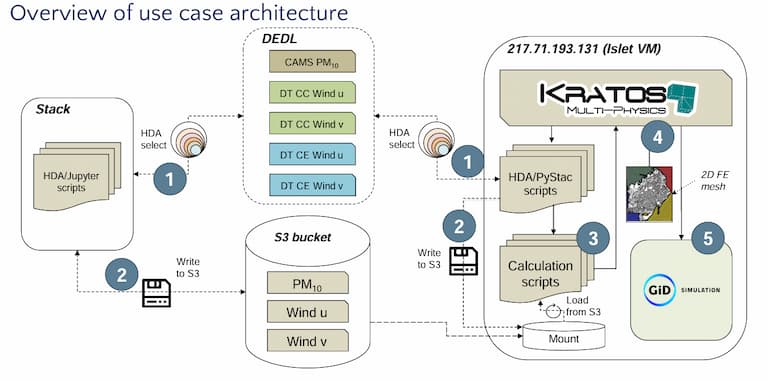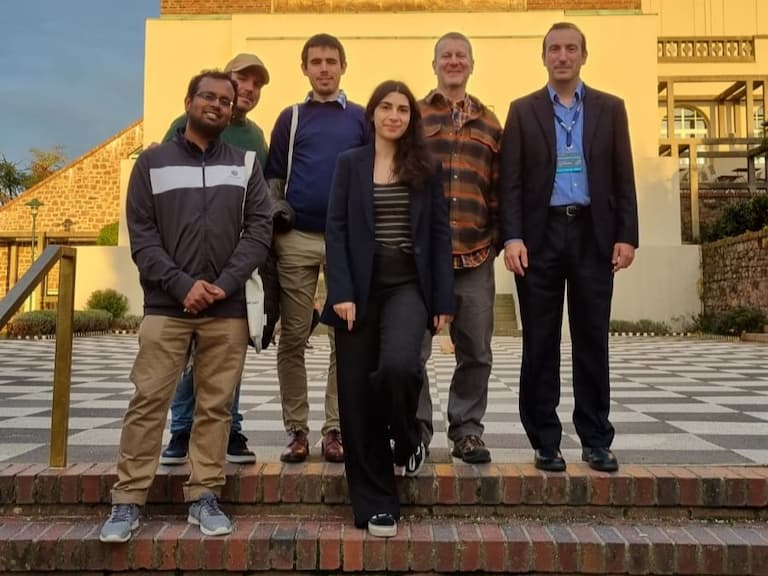CIMNE researchers last week presented two use cases for monitoring air quality in Barcelona and predict energy consumption in extreme climate events in Catalonia, both implemented on the “Data Lake” of Destination Earth, an ambitious European endeavour to create a high-fidelity digital twin of our planet.
As part of the 3rd User Exchange Workshop of the project, Dr. Ignasi de Pouplana and Laurence Sigler shared a micro-scale air pollution model to determine air quality at the street level in Barcelona. This advanced model connects various sources of federated data to determine dust particle concentration of less than 10 microns.
The event was hosted by the European Organisation for the Exploitation of Meteorological Satellites (EUMETSAT) in Darmstadt (Germany), and jointly organized with the European Space Agency (ESA) and the European Center for Medium-Range Weather Forecasts (ECMWF).
Researchers were able to demonstrate the computational capabilities of Destination Earth’s centralized repository (Data Lake) using CIMNE’s Kratos Multiphysics computing framework, yielding output data on the centre’s GiD visualization platform. This allows for high definition, short-term visualization of air quality, with direct application to public health surveillance.
The experts, affiliated to CIMNE’s Structural and Particle Mechanics innovation cluster and Pre, Post and Digital Technologies innovation unit, based part of this model upon the PIKSEL project, a management and predictive tool built on computer models to study environmental, economic, and social phenomena in Catalonia. PIKSEL was designed in coordination with the Catalan Government.
 Overview of use case architecture for the Urban-scale air pollution model
Overview of use case architecture for the Urban-scale air pollution model
using Data Lake’s Near-Data Computing. The use of CIMNE's Kratos Multiphyisics and GiD solutions are part of steps 4 and 5.
Machine Learning to predict extreme energy demand
Dr. Gerard Mor and Miriam Méndez took the stage at the workshop to present their use case for predicting peak electricity demand during extreme environmental events. The model combines several environmental and socio-economic variables to forecast energy consumption at postcode level in Catalonia during heat waves and intense cold spells.
Researchers at CIMNE’s Building, Energy and Environment innovation unit used Machine Learning technology and combined several data sets from different sources in the “Data Lake” of Destination Earth, allowing for easy extrapolation to other geographies and use cases.
The CIMNE delegation at the event.
About Destination Earth
The International Centre for Numerical Methods in Engineering (CIMNE) has been selected as a partner for the Destination Earth initiative, a program by the European Commission to develop a highly accurate digital model of the Earth on a global scale to aid Europe’s “green transformation”. By combining real-time observations with previous data pools, experts are developing highly accurate replica of complex Earth systems, giving special attention to extreme weather events and the effects of climate change.
Destination Earth is jointly coordinated by the European Organisation for the Exploitation of Meteorological Satellites (EUMETSAT), the European Space Agency (ESA), and the European Centre for Medium-Range Weather Forecasts (ECMWF), with financial support provided by the European Commission.









